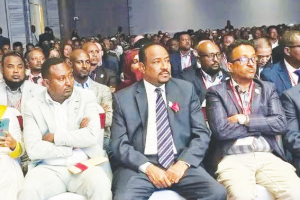BY MULUGETA GUDETA
Adult literacy rate is generally defined as “the percentage of population aged 15 years and over who can both read and write with understanding a short simple statement on his/her everyday life. Generally literacy also encompasses numeracy, the ability to make simple arithmetic calculations.”
There are at least 13 types of literacy registered by researchers. The various types of literacy that have been taken into account in one of the research papers on the subject include computer, vernacular, digital, visual, school, media, health, emotional, cultural and moral literacy.
The literacy rate in any country is taken as one indicator of social development. The United Nations in its annual statistics on social and economic development use literacy rate as a good indicator of what a country stands as far as its overall development is concerned.
According to many experts on the subject there is a direct correlation between the rate of literacy and socio-economic development or vice versa. The two are mutually complementary.
Adult education in Ethiopia dates back to the time of emperor Haile Sellassie who was one of the pioneering monarchs of modern education in the country.
In additional to introducing modern formal education, the monarch was keen to promote adult literacy through a campaign called ye’fidel gebeta or the “chart of alphabets” that contained all the Amharic alphabets and numbers both in Ge’ez and Amharic.
This was a pioneering move in educating the adult population of the time that could not be included in the formal education sector. This scheme was dubbed successful for its time as thousands of adults could be enabled to read, write and do simple arithmetical calculations.
The second wave of adult literacy campaign was introduced by the military government known as the Derg that adopted a program of universal literacy. It was an ambitious program of making Ethiopians in all walks of life, including older people benefit from a sweeping measure to eradicate illiteracy from the country.
It was comparable to the national campaign to eradicated communicable diseases or an epidemic. Illiteracy was rightly perceived as one of the scourges that that stood on the path of socio-economic development both in the countryside and the towns.
The program was even conceived as a panacea against underdevelopment and poverty. By making most people literate, the Derg believed that economic development could automatically turn a poor and agrarian society a modern and developed one.
This may look naïve on the surface, but given the zeal, ambition and energy with which it was introduced. The Derg literacy campaign bore the hallmark of a revolutionary move.
Prior to the introduction of the literacy campaign most adult Ethiopians used their thumbs to sign on documents. They painted their thumbs with blue ink and stamped them on the papers and documents they had to sign for various purposes.
However, it was considered a shame and a sign of laziness to use the thumbs to “sign” on documents after the introduction of the adult literacy campaign. Men and women in their seventies and eighties were thus inspired to do away with illiteracy that was rightly considered a shame and a stigma that made illiterate people laughing stocks in rural and urban societies.
Back in 1976, more than 60,000 young Ethiopians from high schools and colleges were deployed to the countryside in a massive national campaign known as Development through Cooperation Campaign whose objectives included making every adult Ethiopian a literate citizen as well as introduce them to the basics of health care and rural development by distributing millions of reading materials throughout the vast countryside.
The campaign was supported by all citizens as a national and patriotic duty and galvanized unprecedented support for its success. The campaigners were hailed as national heroes who were determined to “open the eyes” of their downtrodden compatriots.
The young students worked hard in often difficult circumstances building makeshift classes or simply using the shadows of trees to gather millions of adults and introduced them to the rudiments of education for the first time in their lives.
Although the program was a revolutionary one, it had the narrow focus of making everyone capable or reading and writing within a given time frame. As it was criticized later on, the program’s narrow focus did not enable the adult students relate their learning to the day-to-day tasks of living and working.
As a result of this millions of people who could read and write quickly relapsed into illiteracy as their learning was not linked to the task of economic activities.
The adult literacy programs under the Derg was terminated as soon as millions of people were qualified as literate after finishing the basics of the program.
Most of them soon relapsed into illiteracy and there was no follow up program to introduce them to higher levels of learning. The program was introduced and conducted with great speed so much so that tens of thousands of people who could not read and write properly were lumped together with those who completed the program and the total number of people considered literate was unrealistically inflated in order to meet the targets set by the programmers.
It was only at a later stage of the literacy campaign that its shortcomings were evident and attempts were made to rectify it. The program was also conceived as a means of enabling people to read and write so that they could raise their political consciousness and implement the programs of the revolution more effectively.
Thus, the program had also a political and ideological components that exacerbated its shortcomings. It was only at a later stage of the adult literacy program that the concept of “functional literacy” was introduced by the military government.
However, the attempt to link literacy with the practical requirements of material production came at the wrong time. When attempts were made to change the first phase of the program into a kind of “functional literacy” the original enthusiasm and hard work had started to wane and the government was losing its revolutionary legitimacy or direction.
Looking back at the Derg’s literacy campaign or zemecha, one cannot but marvel at its initial success as millions of formerly illiterate people were converted into literate ones and many participants in the national program proudly exhibited their newly acquired education whenever they found the opportunity to do so.
Millions of adults past their school ages had become new students in their seventies and eighties and that was rightly considered aa one of the great achievements of the revolution.
Many historians describe the Derg as a brutal and repressive military administration but none of them deny its two cardinal achievements, namely the literacy campaign and the nationalization of rural and urban land.
Regrettably enough both measures backfired as the literacy campaign was stopped and the land reform program degenerated into something that granted land to landless peasants and then turned them into leaseholders from the state.
Feudalism was abolished but peasants were not fully liberated or made the owners of their plots of lands as all land became the property of the military state.
Enter the EPRDF and the massive literacy program that was introduced by the Derg was discarded together with many of its healthier achievements. The EPRDF completely discarded the program and there was nothing replacing it.
True the EPRDF on its part has scored impressive achievements by expediting the development of formal and higher education. It built dozens of colleges and universities as well as thousands of elementary and high schools.
Tens of millions of Ethiopian youngsters starting from the kindergarten to college level were encouraged to attend classes. The net result of this was a kind of inflation of young people with first and second degrees who could not find jobs easily and many of them fell preys to unemployment.
On the other end of the spectrum, tens of millions of adults who could not go through the formal educational process and became illiterate were totally neglected as the literacy classes closed down and there was no budget allocated for them.
We can say that the EPRDF-led government has remarkable achievements and regrettable failures on its scorebook as far as educational development is concerned. The task of overcoming this paradox is yet a work in the process
Although Ethiopia has registered marked improvements in its current rate of literacy, it is not however among the countries where the level of literacy is very high. Thus literacy cam be taken both as an indicator of the socio-economic development of a country as well as its level of cultural development.
High literacy rate means that a growing number of people in any country are capable of reading and writing and this has a direct bearing on educational development. The higher the number of educated people in a country the better the chance of achieving faster economic growth.
The United nations and its affiliate agencies consider the right to education as one of the human rights enshrined in their charters. Education is important because the other objectives of international as well as national governments cannot be achieved without education.
The Ethiopian government too gives primordial importance to the task of educating its citizens. However the rate of literacy in Ethiopia over the last few decades did not grow as fast as expected.
The literacy rate is a figure that shows the number of illiterate adults above the age of 15 who have become literate at a given time. In Ethiopia, the literacy rate stands at something like 63 per cent. In other words 37 percent of adults, or more than 40 million of the total population, do not have the basic skills of reading, writing and doing simple arithmetical calculations. This is something unacceptable by any means in this age of fast information flows and technological progress that facilitates access to basic educational skills.
More than 40 years ago, the military government had sued rudimentary educational tools and materials to achieve impressive results in promoting adult education. With today’s technological progress, something even better can be done in the area of adult education although that requires great commitment, mobilization and resource allocation.
More than 40 years ago the pioneers of adult literacy program regarded illiteracy as a scourge or a dangerous epidemic. Nowadays, illiteracy can be compared to a pandemic that is killing many people in a different way.
The ongoing conflicts in our country and the resulting human casualties are largely caused by people’s lack of consciousness as to what their common interest are. AS most media operators lack what is called media literacy they cannot play a role commensurate with their responsibilities. All this shows that illiteracy, although neglected and forgotten, is playing havoc on the body politic.
Most of all no economic development can be achieved without liberating the critical segments of the population, namely farmers and workers, from the pandemic of illiteracy.
By the same token, cultural development is unthinkable without a strong, practical and functional literacy drive that would liberate the people from the darkness of the mind, that is the evil behind so many of our tragedies as a nation.
The Ethiopian herald January 1/2021




